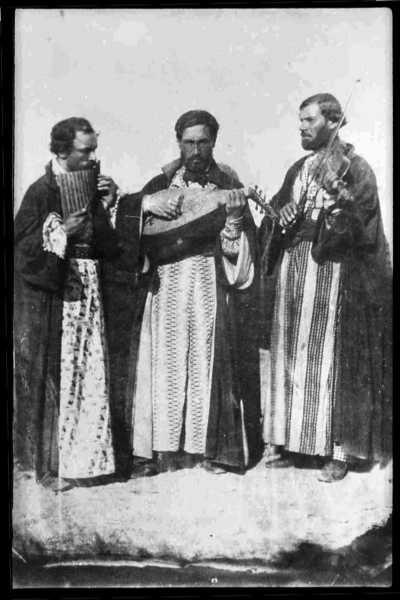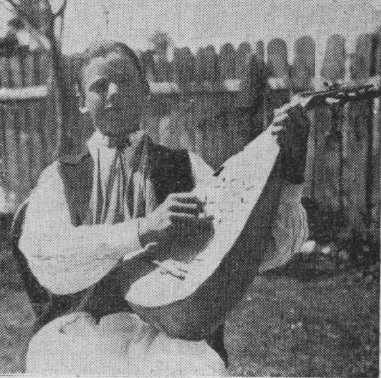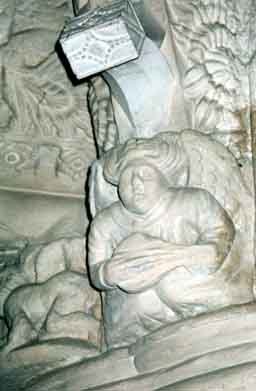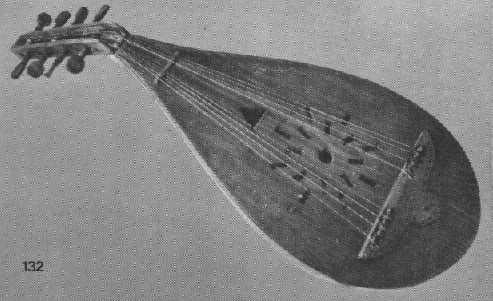
Last updated: 8 January 2016
The cobza (koboz in Hungarian) is a Romanian folk version of the oud, the lute found across the Islamic world from North Africa to Central Asia. The word is Turkish; "kobuz" is the more common form of it in Turkic languages, but it can be applied to many different lute-type instruments. In Europe, the cobza/koboz is now restricted to northern and eastern Romania, played by both Hungarian and Romanian communities, and is also played in Hungary by enthusiasts for Transylvanian and Moldavian Hungarian music.
The following is from Tiberiu Alexandru: Romanian Folk Music (translated by Constantin Stihi-Boos, translation revised by A.L. Lloyd), Musical Publishing House, Bucharest, 1980. Like many Communist-era Eastern European works on folk music, it's very well done; worth reading just for the stunningly poetic translations of some of the folk ballads, which make better sense of them than almost any other rendition of a foreign folk tradition I have ever seen.
Among the chordophones, instruments whose sounds are produced with the aid of strings, the oldest is the cobza. Its forerunners are painted on the walls of several monasteries and churches dating from the sixteenth century onwards. The presentday cobza consists of a half-pearshaped resonance box made up of five or seven ribs ("doage") of walnut and maple, called "burduf" or "bîrdan", with a belly made of thin spruce and a short broad neck ("gît") of strong wood, whose pegbox is bent back at an obtuse or right angle. The strings, of different thicknesses are connected to a deal tailpiece ("cordar") fixed on the lower part of the belly and tightened with the help of pegs ("cuie", literally nails) of strong wood. They are stopped with all the fingers of the left hand and plucked with a goose-quill held in the right hand. Under the spot where the strings are plucked, a small leather patch or thin plate of wood is glued, to protect the belly from scratches. The cobza has 8-12 strings grouped in four courses of two or three strings each. In each course, one of the strings may be thicker than the others. The thicker strings, usually called "Curdoaie", are tuned an octave lower than the thinner ones. Cobza-tunings vary from region to region, even from one player to another (the most common is in fifths and fourths: d - a - d - g).
The cobza is, above all, an accompanying instrument for the lautari [little-u over the a]. It soft, rather angry-sounding tone accompanies the violin either alone or with other instruments. The cobza-player is likely to know a rather small number of "tiituri" [cedilla under the first t] (as the rhythmic-melodic accompaniment figures are called), each with a few variants according to the mode of the tune, the rapidity of its movement, and the talent and skill of the player. Only rarely does one find musicians who venture to play melodies on the cobza, a difficult matter on acount of the very short broad neck of the instrument.
Once very widespread in Moldavia and Muntenia, cobzas have become increasingly rare. In Oltenia they have been replaced by the guitar, which however has lost two or three of its strings, deemed superfluous, while those that remain are tuned rather in the manner of the cobza. The guitar, sometimes called "zongora", is also used by the lautari of Maramures. When Bela Bartok was collecting there, in 1913, it had only two strings, tuned a fifth apart, struck simultaneously, like an invariable pedal, irrespective of the nature of the melody played on the violin. Today the guitars have three strings and the lautari are accustomed to change their tuning in order to fit the melody they are accompanying.
Alexandru mentions that in the 18th century there were bands comprising panpipe, one or two violins, and cobza. He reproduces a picture from a monastery, painted around 1600; it shows a man wearing a crown playing an instrument with 5 courses, the topmost double, no frets, somewhat smaller than an ud, and apparently (the perspective isn't quite clear) held the way some Turkish cümbüs players do it, with the belly tilted up so the player can see the strings. Another photo in the book shows a modern Romanian peasant player holding the instrument in the usual Middle Eastern way, belly vertical and neck horizontal.
This picture of a trio like those described by Alexandru is from Robert Garfias's archives:

There is another short description of the cobza, with a picture of a player from Moldova, in a Hungarian booklet, Dincsér Oszkár, Két Csíki Hangszer, Magyar Történeti Muzeum, Budapest 1943. The text about the cobza is in this large image - in Hungarian, which I know only a few words of. Can somebody translate it for me? Here's the picture extracted from it:

David Kilpatrick in Kelso can supply Romanian-made cobzas though his Troubadour Instruments import operation. They are made by the Hora instrument factory in Reghin, http://www.hora.ro - their website classes it as a mandolin and includes a picture. The factory supplies them in a weird stringing/tuning, with the lower double courses tuned a third apart, rather than an octave. Like this:
8 B, 246.9 Hz 7 D, 146.8 Hz 6 E 329.6 Hz 5 G, 196.0 Hz 4 B, 246.9 Hz 3 B, 246,9 Hz 2 E 329.6 Hz 1 E 329.6 Hz
Unfortunately David seems to have found they're too strange to market in serious numbers (and in that tuning they are strange), so there isn't likely to be a UK subculture of cobza players in the near future.
But they have been brought into Britain before: I once saw a battered old cobza in a junk shop in Glasgow. And something very like a cobza is depicted in the stone carvings in Rosslyn Chapel, from the middle of the 15th century. This picture was taken from Rob McKillop's now defunct website, www.musicintime.co.uk:

A three-course version of the instrument is depicted on a carving at Melrose Abbey, perhaps 200 years earlier. Both the Rosslyn and Melrose lutes are fretless.
I bought one of the Hora cobzas in early 2004. So far, I've restrung
it (using the lower four courses from a set of light 12-string guitar
strings), deepened the nut grooves to lower the action, and tuned it like
a 12-string:
E, E,, A, A,, D D, G G,While this takes it far lower than the factory stringing, it sounds pretty good, with enormous power in the bass for such a small instrument. I pluck it with a cumbus plectrum (see the cumbus page on this site) and with the sort of plectrum used by the Csángó Hungarian minority in Moldavia - a 1-centimeter-wide ring cut out of a PET soft drink bottle. It can either play tunes in the Scottish nine-note bagpipe scale based on A with a few notes to spare each side of it (as the Csángó player Vasile Paun uses it), or else it can be used as a very portable miniaturized acoustic bass guitar. It has the assertive sound of a far bigger instrument and can be heard through a roomful of fiddles. The drawback of the heavier strings is that it's hard to tune them using the pegs, and there's no room to fit micro-adjusters. Getting the higher (unwound) A string to stay in tune is a pain. Some players replace the pegs with machine tuners, as in these three pictures (here, here, and here) from the Gyimes folk camp in 2008.
A very different kind of cobza is in the collection of the Horniman Museum in London, http://www.horniman.ac.uk. Here is a picture of it from their 1970 musical instruments catalogue:

They tell me:
The cobza in the Horniman Museum is Museum number 1.1.57/2. According to the notes dated June 1956 compiled by Elena Secosan of the R.P.R Museum of Peasant Art from whence the object came, it was made by the Romanian Dmitru Clipit (b.1895), Straja village, Radauti district, Suceava region, Romania, c. 1946.
The stringing is different; instead of four double courses, there are two sets of four single ones separated by a sizable gap, with one of the groups having thicker strings. There is also one fret. I've seen this in the museum but haven't heard it played or tried to play it myself; one guess might be that each set is tuned to sound a chord, with the fret being used to shift all four strings of a set upwards together using a barre, which could give a choice of four chords with no need to stop the strings at an unfretted point.
There is a substantial Romanian text on cobza playing (DAdg tuning): C. Zamfir and I. Zlotea, Metodá da cobzá, Bucharest 1955. This has been reprinted and is available here:
Some recordings of Zlotea and other Romanian players are now on the web in mp3 format, in Robert Garfias's ethnomusicological treasure trove at uci.edu:
The first of Zlotea's horas has a few bars that bear an uncanny resemblance to the modern Canadian reel "The Mouth of the Tobique", which is often used for dancing in Scotland.
There is a substantial amount of technical and ethnographic information in Sándor Balogh's book of Moldavian instrumental tunes (in Hungarian), available from Ferenc Kiss's Etnofon folk music publishers in Budapest. This includes music transcriptions, strumming patterns and chord diagrams (mostly for DAdg tuning) which are easy to use even if you don't know any Hungarian. It includes a CD. The koboz material is about a third of the book, which also covers whistles and the fiddle. Getting hold of it from abroad is painful but possible.
There is also an instructional DVD for the koboz, in Hungarian: http://koboziskola.hu/.
Some cobza recordings on the web:
This page stimulated an interesting discussion on an ud forum, with many sound samples and images being posted. Look at it here: Mike's Oud Page cobza thread.
There is a fretted variant of the cobza only found in Moldova. Violeta Zaplitnii from Chisinau uses it like a jazz guitar in duo with her husband on the accordion. Their website (in Italian, follow the "Duo Rev" menu item), YouTube video and another video. Violeta is gorgeous.
I would like to hear from cobza/koboz players (in any genre) who have samples available on the web, so I can link to you.